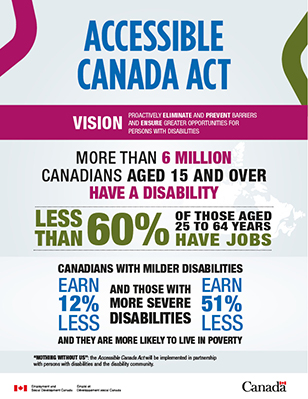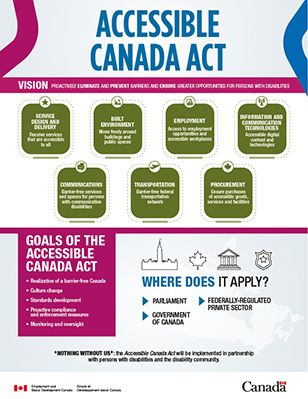About an Accessible Canada
All Canadians have the right to take part fully in society. Advancing accessibility is about creating barrier-free communities, workplaces and services for all Canadians. This is especially important to the more than 6 million Canadians, aged 15 and over, who have a disability.Footnote 1
In 2010, Canada ratified the United Nations Convention on the Rights of Persons with Disabilities (UNCRPD). By signing the UNCRPD, the Government of Canada committed to furthering the rights of persons with disabilities.
The development of national accessibility legislation – the Accessible Canada Act (ACA) – fulfilled the Government of Canada’s commitment to accessibility and the rights of persons with disabilities. The development of this legislation involved significant consultation with stakeholders, and the disability community in particular. The resulting Accessible Canada Act is landmark federal legislation that aims to realize a barrier-free Canada by 2040.
A key principle of the ACA is “Nothing Without Us”, which means that persons with disabilities should be consulted when developing laws, policies and programs that impact them. In keeping with this principle, the Government of Canada works with persons with disabilities, and organizations who advocate on their behalf, to better understand the full diversity of the community it serves.
Consultation on a draft Accessible Canada Roadmap New
You can share your views and experiences about the Accessible Canada Roadmap until January 8, 2025.
The Accessible Canada Act
The Accessible Canada Act (ACA) came into force in 2019. The overarching goal of the ACA is to realize a barrier-free Canada by 2040. The legislation benefits all Canadians, especially persons with disabilities, through the proactive identification, removal and prevention of barriers to accessibility in 7 priority areas:
- employment
- the built environment
- information and communication technologies (ICT)
- communication other than ICT
- the design and delivery of programs and services
- the procurement of goods, services and facilities
- transportation
The ACA applies to a wide range of federally regulated entities. This includes, for example:
- industry sectors such as banking, telecommunications and transportation
- Government of Canada departments and agencies
- Parliament
- Crown corporations
- Canadian Armed Forces
- Royal Canadian Mounted Police, and
- First Nations band councils
The ACA requires regulated entities to prepare and publish accessibility plans, set up feedback processes and report openly on progress. The ACA gives the authority to create and enforce accessibility regulations.
The ACA establishes a framework for advancing accessibility through a combination of new and existing organizations and positions which administer and enforce the ACA, and monitor outcomes.
The legislation established Accessibility Standards Canada (ASC) to develop national accessibility standards. ASC has established several technical committees that are actively developing standards that remove barriers in several different priority areas. Compliance with standards developed by ASC is voluntary unless they are adopted into regulations.
The ACA also created 2 new roles:
- the Chief Accessibility Officer (CAO): as an adviser to the Minister on accessibility issues, the CAO will release annual reports on what has been achieved in realizing a barrier-free Canada, and
- the Accessibility Commissioner: responsible for compliance and enforcement under the ACA
A summary of the Accessible Canada Act is available.
Visual representations
The Accessible Canada Regulations
The Accessible Canada Regulations (ACR) came into force in December 2021. The ACR are the first set of regulations under the ACA. The ACR establish the rules that federally regulated entities must follow when publishing accessibility plans, setting up feedback processes, and developing progress reports.
Guidance materials are available to help federally regulated entities meet or exceed the regulatory requirements.
A summary of the Accessible Canada Regulations is available.
First Nations Band Councils
Based on feedback provided while the ACA was being developed, the Government of Canada has committed that the ACA would not apply to First Nations band councils until further engagement with Indigenous persons.
While this engagement work is ongoing, the Government of Canada has exempted First Nations band councils from the ACR for 5 years, until 2026. This exemption provides Indigenous organizations with more time to engage their member communities in order to better understand the accessibility barriers faced by Indigenous persons with disabilities. Continued engagement reflects the Government of Canada’s commitment to advance reconciliation with Indigenous peoples
Measuring progress
Measuring progress on the implementation of the ACA is important for realizing a barrier-free Canada. ESDC collaborates with Statistics Canada and other federal partners to collect and analyze accessibility data under the Accessibility Data and Measurement Strategy. This 5-year strategy proposes work in 4 core areas:
- Identify Knowledge and Data Gaps, and Develop Indicators
- Promote Common Approaches to Measurement
- Expand and Integrate Data Sources
- Data and Knowledge Mobilization
A key step in mobilizing accessibility data was the launch of the Accessibility Data Hub. The Hub is hosted by Statistics Canada. It is a centralized web portal presenting data on topics related to accessibility and disability. It is organized around the 7 priority areas set out in the ACA.
National AccessAbility Week
The Government of Canada first launched National AccessAbility Week in 2017. With the coming into force of the Accessible Canada Act in 2019, National AccessAbility Week became legislated to take place every year, starting on the last Sunday in May.
During National AccessAbility Week, a number of activities and events planned by accessibility and disability stakeholders, persons with disabilities, as well as provincial and territorial partners, take place to celebrate:
- the valuable contributions of Canadians with disabilities; and
- the efforts of individuals, communities and workplaces that are actively working to remove barriers to accessibility and inclusion
The removal of existing accessibility barriers and prevention of new barriers will create a more inclusive society that provides greater access and opportunities for persons with disabilities. This helps communities to thrive and the economy to prosper, which benefits all Canadians.
The United Nations Convention on the Rights of Persons with Disabilities
Canada joined the United Nations (UN) Convention on the Rights of Persons with Disabilities in 2010. The Convention protects and promotes the rights and dignity of persons with disabilities without discrimination and on an equal basis with others.
In December 2018, Canada also joined the Optional Protocol to the Convention. The Optional Protocol allows individuals and organizations to make a complaint to the UN if they believe their rights under the Convention have been violated.
Accessible Canada funding
Following the coming into force of the Accessible Canada Act, annual Accessible Canada funding has been committed under the Social Development Partnerships Program – Disability Component. This funding supports projects that focus on accessibility. There are 2 funding streams:
- Accessible Canada funding - National AccessAbility Week (NAAW): to support NAAW celebrations and activities that:
- highlight the contributions of persons with disabilities, and
- promote accessibility and inclusion in communities and workplaces across every province and territory
- Accessible Canada funding - Accessible Canada Partnerships (Partnerships): to fund projects that support:
- key partnerships between the disability community and the federally regulated sector, and
- the disability community to continue to engage on the implementation of the Accessible Canada Act and its regulations
Each stream holds separate calls for funding. Eligibility criteria will be further defined during each funding process.
Related links
What we are doing
Consultations
News
- Government legislation to support Canadian workers businesses persons with disabilities and legal rights receives royal assent
- Minister Qualtrough announces new details on proposed financial support for persons with disabilities during COVID-19
- Statement by Minister Qualtrough on the anniversary of the Accessible Canada Act
- Government of Canada announces appointments to the Canadian Accessibility Standards Development Organization
Backgrounders
Page details
- Date modified:

